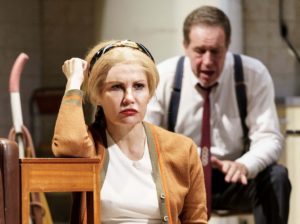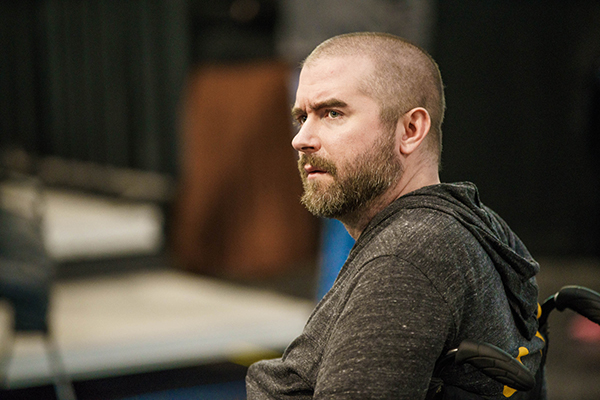Blind leading the blind: an actress who can’t see gets the Audrey Hepburn role in Wait Until Dark
October 1, 2017 • 8 Comments • Posted in blindness, careers/jobs for people who are blindWhen Chicago’s Court Theatre produced Wait Until Dark on stage nine years ago, they asked me to be a technical consultant.

Karina Jones in Wait Until Dark.
In the movie version, Audrey Hepburn played the lead: a blind woman terrified when a psychopath breaks into her apartment. In the Wait Until Dark chapter of my new book, Writing Out Loud, I explain that while I have no expertise in anything psychopathic, “I do know what it’s like to be newly blind and married to a man who can see, and that’s what the cast wants to know about. How can I say no?”
I loved being a tech consultant, but when I bragged about the actress playing the Audrey Hepburn character coming over to watch how I move around our apartment and get errands done, or when I was with friends and shared some of the questions I’d been asked by the handsome actors (why picture them otherwise?) on the set, those friends would inevitably ask, “So why don’t they just have you play the part?”
The easy answer was that I am not an actor and don’t know a thing about acting. The more complicated answer was that back then, even if I’d studied acting, I wouldn’t have been considered: actors with disabilities were not getting many roles on stage or in Hollywood nine years ago.
But that’s beginning to change. last year I wrote two posts about actors with disabilities scoring major parts:
- Michael Thornton rolled onto the stage in his wheelchair to play the lead role in Gift Theater’s production of Shakespeare’s Richard III at the Steppenwolf, and
- Micah Fowler, a young actor with cerebral palsy was cast as a character with CP on the TV comedy Speechless.
And then there’s four-foot-five actor Peter Dinklage, who won an Emmy for his role as Tyrion Lannister in HBO’s Game of Thrones, And now actor Mickey Rowe is one of the first actors with autism to play a character with autism on a major professional stage: He’s playing the lead role in the Tony award-winning play Curious Incident of the Dog in the Night-Time at the Indiana Repertory Theatre before it opens at New York’s Syracuse Stage October 25th.
But wait. There’s more! Nine years after my debut as tech consultant, for the first time ever, an actress who is blind has debuted as the lead in Wait Until Dark, too! I got in touch with British actress Karina Jones after she landed the Audrey Hepburn role. Turns out she’d lost her sight as a young teenager, and she shared a link to an interview to share with you all that gives more information on her background –including her time as a circus tightrope walker and trapeze artist!In that same interview she expresses her surprise about her part in Wait Until Dark: “It’s 2017 and yet I am the first blind actress to take the role of a blind person in a play that has been around since the 60s. Why?” More from the interview:
“Producers and directors should give disabled roles to disabled actors. A blind person wouldn’t be auditioned for, say, Desdemona – we’re not there yet – but with roles that are written as disabled or impaired I think it is only fair that they should be played by disabled actors. In this play I’ve totally got an advantage [over a sighted actress] because I’ve got a lot of shorthand. I’ve got a head start because I have real insight into the character. Playing this part is, for me, an amazing thing; a real push forward for equality. It’s brilliant.”
The play opened at Devonshire Park Theatre in Eastbourne on August 24, 2017 and is on a UK tour now. They’ll be in Exeter next week,and the tour continues until December. For tickets and more information, visit www.waituntildark.co.uk”.


